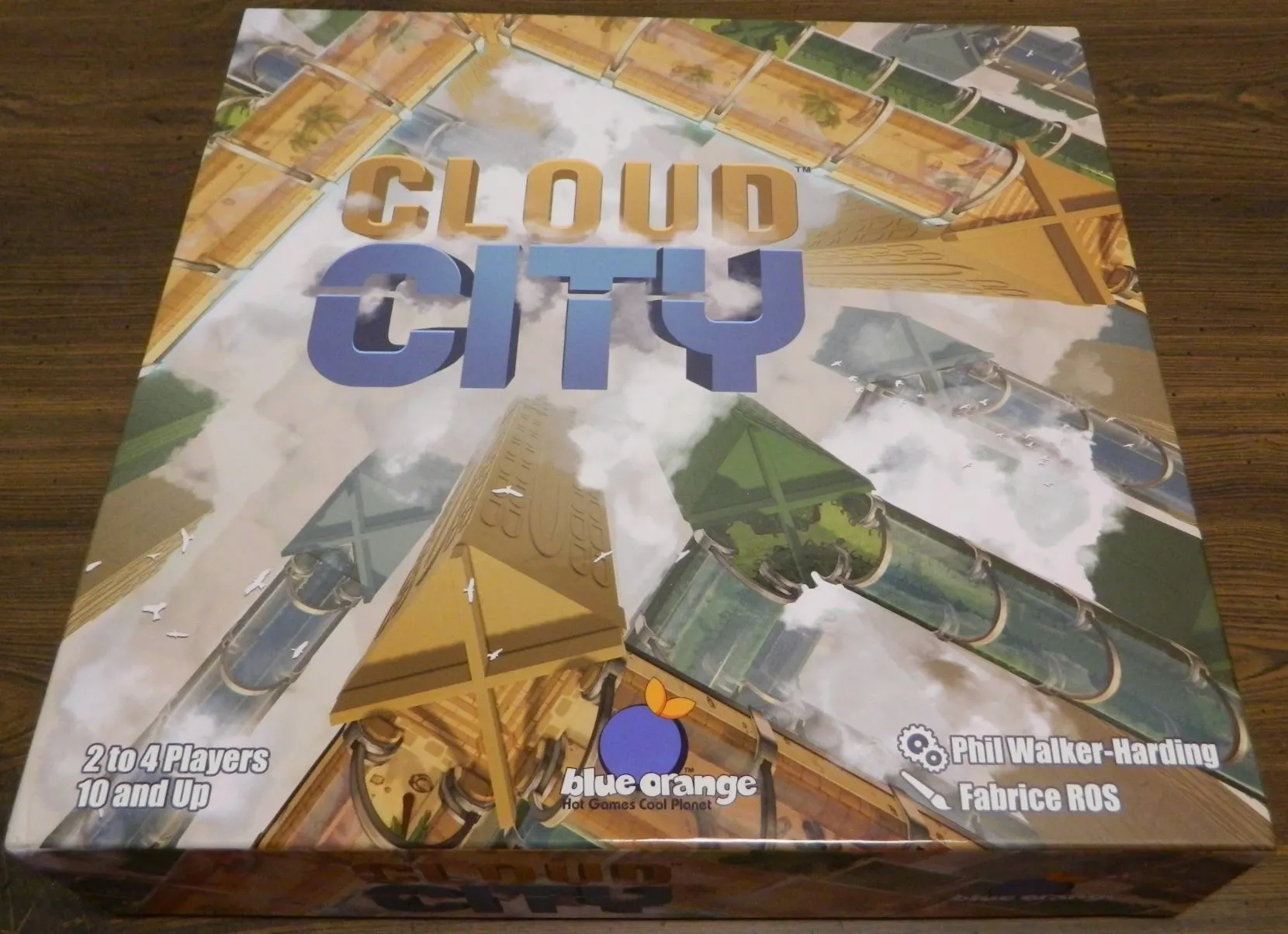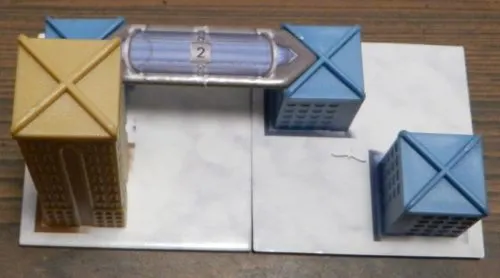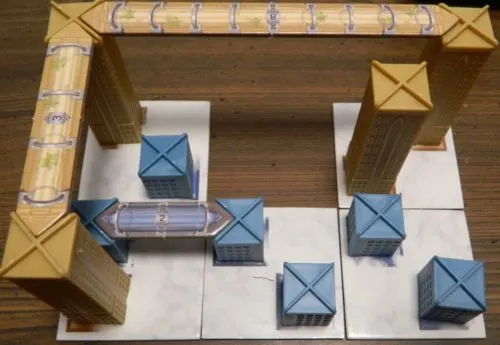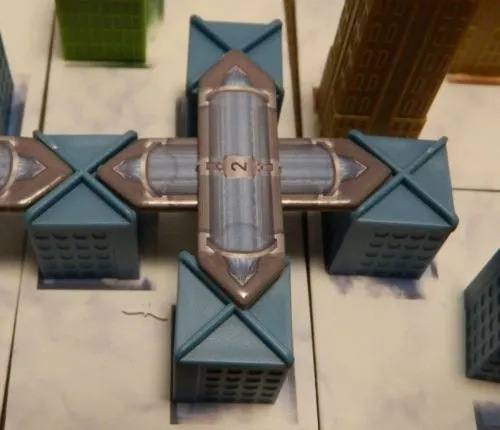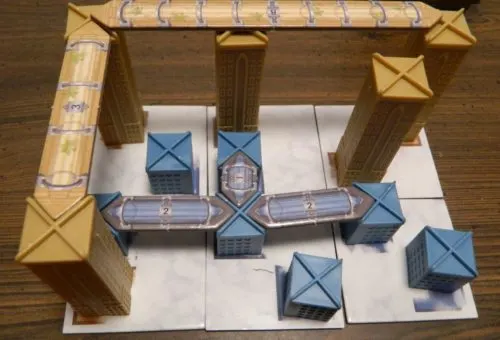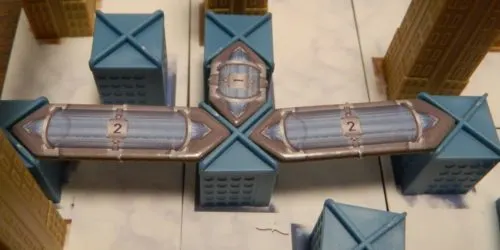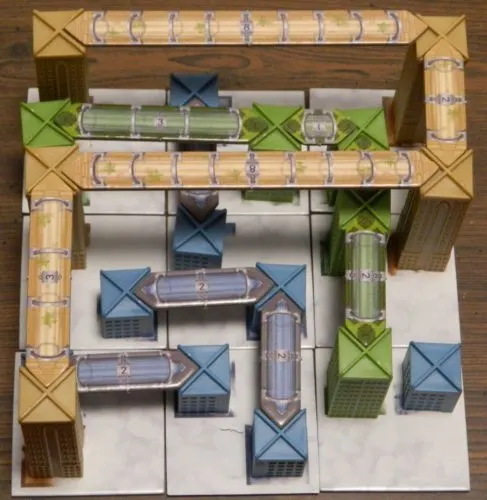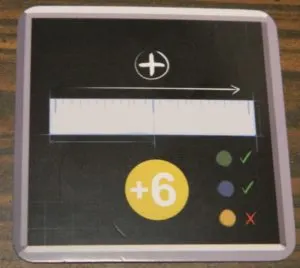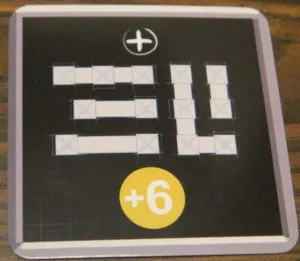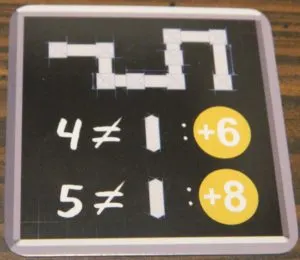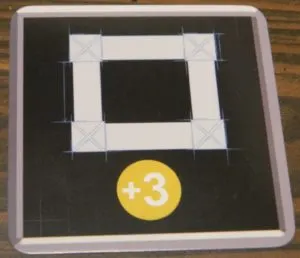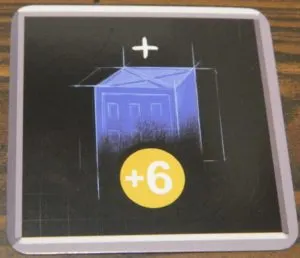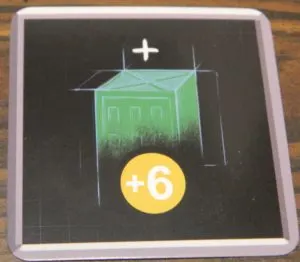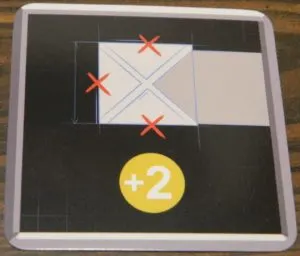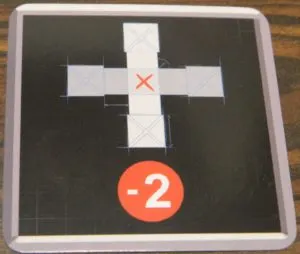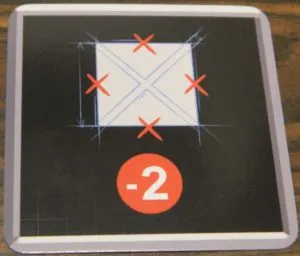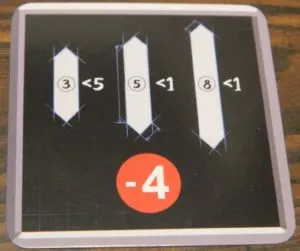Any regular readers of Geeky Hobbies will know that I am a big fan of Phil Walker-Harding. He has only designed some of my favorite board games including Gizmos, Sushi Go!, and Sushi Go Party!. When Blue Orange Games sent me a copy of his latest game, Cloud City, I was really excited to check it out as the success rate of his games are quite high. The fact that the game utilizes a city building theme with tile placement mechanics and 3D buildings made me even more excited. Cloud City does a fantastic job finding the perfect balance between simplicity and strategy to create a game that everyone from the casual to hardcore gamer can enjoy.
How to Play Cloud City
Setup
- Remove the starting tiles (the tiles that have birds on them) from the rest of the tiles.
- Shuffle the rest of the tiles together and place them in a stack in the middle of the table.
- Turn over the top three tiles and place them next to the stack of tiles.
- The player whose “head is most in the clouds” will be the first player and will be given the starting tile featuring one bird. The next player clockwise will take the tile with two birds and so on. If any of the starting tiles aren’t used they are returned to the box.
- Each player will take two buildings that match the color(s) of the building spaces on their tile. The buildings will be placed on the corresponding spaces.
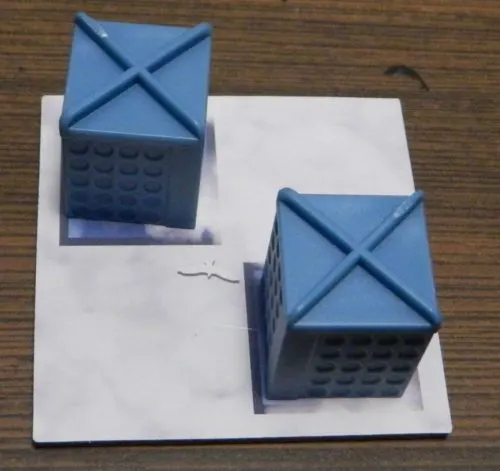
- Each player is dealt three cloud tiles which will form their hand. These tiles will be kept secret from the other players.
- If you aren’t using the “Upgraded Models” variant return the Special Request cards to the box.
Playing the Game
The game is played over eight rounds. On a player’s turn they will take four actions:
- Expand the base of your city (mandatory).
- Choose and place buildings (mandatory).
- Build walkways (optional).
- Draw a tile (mandatory).
Expand the Base of Your City
To begin your turn you will choose one of the tiles from your hand and add it face up to your city.
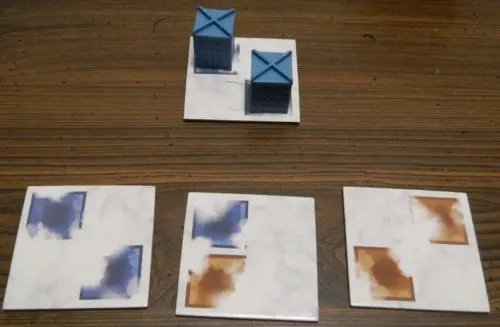
The three tiles along the bottom are the tiles this player has in their hand. They will choose one of the three tiles to add to their city.
When placing the tile you must follow a couple rules:
- Each tile that is placed must touch at least one other tile.
- Tiles can be rotated in any direction before being placed.
- As you will eventually build a 3 x 3 (4 x 3 in two and three player games) city you cannot place a tile in a position that would prevent you from creating the 3 x 3 city.
Take and Place Buildings
Once you have placed your tile take buildings of the colors present on the tile that you just placed. You will put these buildings on the corresponding spots on the tile.
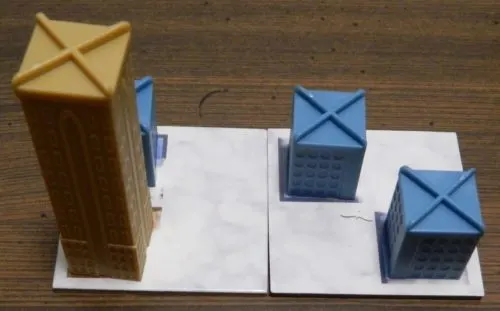
This player has added the second tile to their city. As the tile featured a brown and blue building they will place the corresponding buildings on those spaces.
Build Walkways
This is the only action in the game that is optional. After placing the tile and buildings you have the ability to place walkways between the buildings in your city. You can place as many walkways as you want with this action (anywhere in your city) as long as you don’t violate one of the rules listed below.
To build a walkway you need to find two buildings of the same color/height that can be connected. You will then find a walkway of the corresponding length from the supply and place it on top of the two buildings. If the corresponding length walkway is not available you cannot build a walkway between those two buildings. The number on the walkway indicates how many votes/points you will score from it at the end of the game.
When placing walkways you must follow these rules:
- You may not place a walkway that crosses an empty spot in your city.
- You cannot place a walkway if it will cross another walkway of the same height.
- Walkways cannot be placed diagonally.
- All walkways must be between two buildings of the same height.
- Each walkway can only touch the two buildings at the ends of the walkway. You can’t have a third building along the path that connects the other two buildings.
- Each building can only have two walkways on it.
Draw a Tile
To end your turn you will draw a new tile to replace the tile you played. You can either choose to take the top tile from the face down stack or one of the three face up tiles in the middle of the table. If you choose one of the face up tiles, a new tile from the stack will be revealed to replace the tile that was taken. Play will then pass to the next player clockwise.

This player can either choose one of the three face up tiles or the top face down tile to add to their hand.
End of Game
The game ends after all of the players have completed their 3 x 3 city.
Each player will count up how many votes/points they scored by adding up the numbers on each of their walkways.
The player that earned the most votes will win the game. If there is a tie the tied player with the most votes from the blue walkways wins. If there is still a tie the tied player with the most votes from green walkways wins the game. If the game is still tied the tied players will compare votes from the light brown walkways. If the game is still a tie, the tied players share the victory.
Variant Rules
2-3 Player Games
Instead of building a 3 x 3 city all of the players will build a 3 x 4 city (11 total rounds).
Upgraded Models
If you choose to use this variant you will include the Special Request cards in the game. You will shuffle them at the beginning of the game and choose one to use in the game. The rest of the cards are returned to the box.
The Special Request cards give players additional ways to earn/lose votes in the game. In addition to scoring votes for their walkways, players will earn/lose votes based on the card that was chosen. The Special Request cards are as follows:
Most Valuable Route: Each player will count the value of each of their routes (walkways that are connected to one another) on the green and blue levels. The player whose route is most valuable will receive six additional votes at the end of the game. If there is a tie the tied players each will receive three points.
Most Separate Routes: Each player will count up the number of separate routes that they have in their city (groups of walkways not connected to one another). The player who has the most separate routes will receive six additional votes. If there is a tie all tied players will receive three votes.
Varied Routes: For this card players are trying to create routes that utilize different lengths of walkways. If a player can use at least four different walkway lengths in a route they will score six votes. If a player can use five different walkway lengths they will score eight votes. Each player can only score this bonus once in the game.
Circuits: For each route that a player creates that is a circuit they will score three votes. A circuit involves a route of four or more buildings where the route begins and ends on the same building.
Blue Buildings on the Hill: The player that has the most blue buildings will receive six votes. If there is a tie all of the tied players will score three votes.
Green Buildings on the Hill: The player with the most green buildings will receive six votes. If there is a tie all of the tied players will receive three votes.
Minimalist Buildings: All buildings with only one walkway on it will receive two votes.
Crossed Walkways: Whenever a player has a walkway that crosses another walkway (different levels) they will lose two votes. A walkway going over the top of a shorter building does not count towards this.
Solo Buildings: Any building in your city that doesn’t have a walkway will lose two votes.
Balanced Walkways: You will lose four votes if you do not have 5 walkways worth 3 votes, 1 walkway worth 5 votes, and 1 walkway worth 8 points.
My Thoughts on Cloud City
I have to admit that I don’t know exactly how I would classify Cloud City. I have played over 800 different board games, and I can’t remember one that played quite like it. It shares some mechanics from other games, but combines them into a really unique package that really stands out. For this reason I have a hard time classifying it into a specific genre. The best I could probably do is say that it feels like a tile placement game that utilizes 3D elements combined with route building and abstract mechanics. To give you a better idea of what it is like playing Cloud City I am going to break the game down into its main mechanics.
At its core Cloud City is built around a tile placement mechanic. Each turn in the game begins with you choosing a tile from your hand and adding it to the tiles that you have already placed. Unlike a lot of tile placement games there aren’t many rules dictating how you place tiles. Basically the only rule is that you are building a 3 x 3 (3 x 4 in 2/3 player games) city block. On the surface this seems kind of basic and it somewhat is. This tile placement mechanic creates the foundation for the rest of the game.
You could haphazardly create your city, but it likely won’t lead to much success in the game. There are almost no rules on how you place tiles, but this is a critical decision in the game. Each tile in the game features two buildings on it that you will add once the tile is placed. These buildings come in three different sizes with the blue buildings being the shortest and the brown buildings being the tallest. The ultimate goal in the game is to place buildings in your city that you can later connect to one another with walkways that tower above the ground. As walkways can only connect buildings that are in the same column or row you need to be careful to place tiles in a way where you can build walkways between them. When placing tiles you also have to consider the different heights as shorter buildings have to worry about taller buildings that get in their way.
In the game you are ultimately trying to create a three layered city with walkways crosscrossing one another in order to maximize your space to score more points. The walkways in the game come in different lengths based on how far apart two buildings of the same height are from one another. Buildings that are closer to one another are easier to connect and require less planning. They are also worth less points though. The walkway values are as follows: 1, 2, 3, 5, 8. While you will have to make some shorter paths to maximize your city, you need to create some longer paths if you want any chance of winning. To place an eight point walkway you need to have two buildings as far apart as possible which requires quite a bit of planning. You generally have to think two or three turns in the future to truly maximize your city.
These walkways become critical as they are the only way to score points in the game (unless you use the Special Request cards). The catch is that there is not an unlimited supply of walkways in the game. When a player takes the last walkway of a given length players can no longer build a walkway between two buildings of the corresponding height and length. The game gives you the opportunity to play as many walkways as you want on your turn or you could wait to place a walkway on a future turn. At times it might be wise to wait to place a walkway as each building can only have two walkways that connect to it. You don’t want to wait too long to take a walkway though because it could be gone before your next turn. Missing out on a walkway leaves points on the table as you can no longer take advantage of that connection for the rest of the game.
In many ways I like this mechanic as it introduces most of the game’s player interaction. In a lot of ways players are creating their own little cities where the other players can’t impact them in any direct way. Other than taking one of the face up tiles that a player wants, you can’t do much to interfere with the other players. Competing for these walkways can have a pretty big impact on the game though. The competition for some of the walkways can be quite chaotic as in one game we had multiple players that all wanted the last of one of the long walkways. This scarcity forces you to keep track of what the other players are doing and it sometimes forces you to adjust your layout to deal with a walkway length that may no longer be available. For some of the lengths I think there are a little too few walkways though which creates competition for them a little too early in the game. I maybe would have added one walkway to a couple of the lengths.
Seeing as the game was made by Phil Walker-Harding I have to say that I was expecting the game to be pretty accessible. I made this assumption as he has a good track record of not making a game any more difficult that it needs to be. Even with this expectation I actually found Cloud City to still be easier than I expected. The game has a recommended age of 10+, but I could easily see children younger than that being able to play the game. The rules are really straightforward to the point that the game can be taught in minutes. For this reason I think Cloud City is a perfect gateway game. The game may take a little time to get used to for people that only play mainstream games like Monopoly as it is likely different than any other game that they have ever played. They should adjust to the game pretty quickly though and the game is simple enough that it might encourage them to start trying other more complicated games in the future. I can see Cloud City working well for the entire family.
While Cloud City is really accessible there is still enough strategy to the game to maintain the interest of people who generally prefer deeper games. The mechanics in the game are really simple, but the game still gives you quite a few options. Between how you place the tiles and which walkways you add you have a lot of impact over your fate in the game. You can learn how to play the game within minutes, but it will take quite a few games to figure out how to maximize your score. There might be a little luck regarding what cards are available and whether other players mess with your strategy. Your decisions are going to play a much larger role though. Cloud City does a really good job finding the right balance between simplicity and strategy where casual and hardcore gamers should enjoy their time with the game.
One thing I haven’t addressed yet are the Special Request cards. I probably would recommend not using them in your first game with new players so they have an opportunity to adjust to the game’s mechanics. The basic game is quite enjoyable on its own. After your first game though I would probably recommend using them as they bring another dynamic to the game without adding much difficulty. The Special Request cards basically give you extra ways of scoring/losing points. These give players things to think about while they are building their city. This adds some strategy to the game as you try to work these requests into the design you otherwise would have created. With only one card being used each game and there being ten different cards they also keep the game fresh as two games won’t play the same. You can have plenty of fun with just the base game, but I would highly recommend using these cards once you are familiar with the basic rules.
Before wrapping up I want to quickly talk about something that doesn’t really have any impact on the actual gameplay that I still really enjoyed about Cloud City. In Cloud City your basic goal is to build a city that towers into the clouds. No matter how well you do in the game, it is really satisfying building your city and looking at what you created at the end of the game. Between all of the skyscrapers and the walkways connecting them you end up with a thriving city with crisscrossing paths spread over three different levels. The game makes it really feel like you are building a city.
The reason that this aspect of the game succeeds is because the game’s components are really well made. The game mostly includes the buildings, tiles and walkways. The tiles and walkways are made of cardboard, but they are quite thick and durable. The buildings are made out of plastic. They show quite a bit of detail for how many buildings that the game includes. At first it was a little hard to judge which walkway size would be needed to reach across a gap, but you adjust to this pretty quickly. What helps this is the fact that each of the buildings have a groove on top of them which makes it really easy to place the walkways between two buildings. The only time I had any issues is when I tried to weave in a walkway to a lower level when a higher level above it already had a walkway in place. All of the components are put into a box that fits the game perfectly as there is very little extra space in the box.
Should You Buy Cloud City?
Due to Cloud City being designed by Phil Walker-Harding I had pretty big expectations heading into the game. While I don’t think Cloud City is quite as good as some of his other games that I have played, it is still a great game. The game doesn’t really fit into a traditional board game genre as it has elements of tile placement, route and city building, and even some abstract. The game succeeds because it finds the perfect balance between accessibility and strategy. You can learn the game within minutes and yet there is enough strategy in the game to keep anyone interested. Building your own city is really satisfying which is helped by the game’s components. The game gives you plenty of options where your fate is mostly in your own hands.
I really enjoyed playing Cloud City and would recommend it to most people. If the premise behind the game interests you at all I think you will get quite a bit of enjoyment out of the game and should consider picking it up.
Buy Cloud City online: Amazon, Blue Orange Games
We would like to thank Blue Orange Games for the review copy of Cloud City used for this review. Other than receiving the review copy we at Geeky Hobbies received no other compensation. Receiving the review copy had no impact on the content of this review or the final score.

